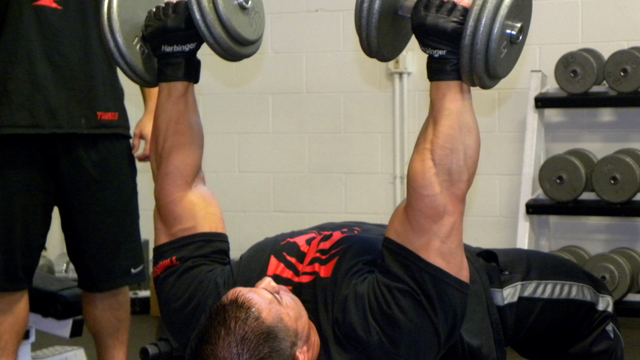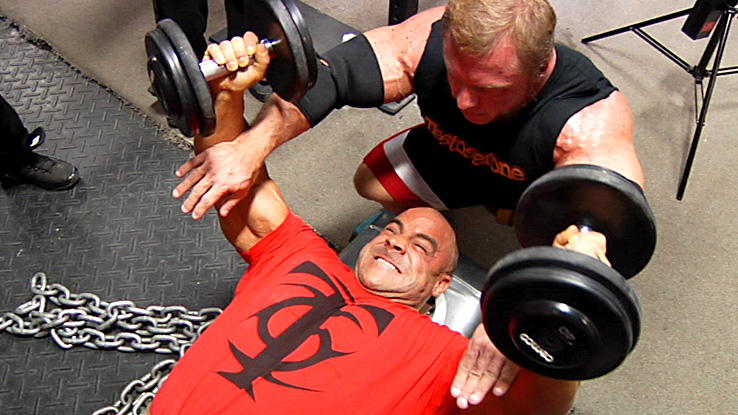Manipulate Frequency and Volume for Growth & Strength
How often you train and the total amount of work you do in the gym, otherwise known as frequency and volume, are two of the most important variables you can manipulate for improving muscle growth, strength, and performance.
In the past, most experts thought that having once-per week, high-volume training workouts for a particular body part was optimal for growth. Now, science is beginning to reveal that spreading that volume over multiple workouts may be more advantageous for building muscle and improving strength.
In fact, new research shows that increased training frequency is almost an imperative for anyone who's not a rank newbie. Why? It starts with protein synthesis.
In order to fully understand how training frequency influences muscle growth, you need to understand what drives muscle growth and how it changes over time.
Currently, the leading theory behind how muscle actually grows is because of something called muscle protein synthesis. (1) When you work out and stress your muscles sufficiently, you up-regulate the process of protein synthesis, which allows the body to combine amino acids into new proteins, i.e., new muscle tissue.
However, it's important to recognize that the process is a rate that diminishes when you become experienced. As a beginner, the amount of time that protein synthesis is elevated in response to exercise is quite long, with some studies showing upwards of 48 hours. That means that as a beginner, your ability to grow new muscle from a single workout can last a few days. (2)
New research, however, tells us that as you become more experienced and more resilient to stress, the amount of time the body spends growing muscle from a single workout decreases significantly. In fact, some research shows that for experienced lifters, this rate of muscle building can actually return to baseline within 16 measly hours. (3)
This is one of the biggest reasons why it becomes increasingly more difficult to grow as you become more experienced, and all the more reason experienced lifters need to start training more frequently.
Bottom Line: The body responds to exercise by increasing protein synthesis. As a beginner, this response is intense and lasts a long time. As you become more experienced, though, this growth response diminishes, making once-a-week single-body part workouts less and less effective.
Increasing how often you train certain muscle groups means you'll have less volume per workout, but you'll also have the opportunity to incorporate greater volume overall.
For example, let's say you're a newbie and you train legs once per week and do 8 sets of squats. That's a lot of sets and chances are you're exhausted and will remain sore for days afterwards. But if you're experienced, the actual growth response to that session might be over with by the next day.
This means that despite the difficulty of your workout, an experienced lifter might only be growing for a day or so in response. That leaves the rest of the week when those muscles aren't growing.
But let's say you split the amount of work you did during that single workout over two training sessions. Now you're doing 4 sets of squats, twice per week. When you make this change, a few things happen. First, you're reducing the amount of work you're doing per workout, but what you get in return is a better ability to recover and the opportunity to use more exercises.
Consider that in the example you completed 8 sets of squats. By working legs twice a week, you have the opportunity to do 4 sets of squats and maybe 4 sets of leg press, for example.
Second, you're increasing the amount of time you spend growing. If you're experienced and you hit a certain muscle group only once per week, it's likely that you're spending almost 5-6 days without growth. When you increase the frequency that you train certain muscle groups, you're now essentially doubling the amount of time you spend growing.
All together, the benefits of increased frequency means that you can do more work over time, while also spending significantly more time each week growing.
Bottom Line: Increasing frequency allows you to reduce training volume per workout, meaning your recovery is better and energy levels are higher, allowing you to use different exercises and potentially perform more work overall.

When you decide you want to increase your training frequency, you need to do so in a sensible manner and at the right time. If you're a newbie, I don't suggest increasing frequency until you become a bit more experienced, which for most people will probably be after 4-6 months of consistent training.
Start by increasing the training frequency of one muscle group at a time to twice per week. Don't try to do too much at once. To avoid injury or poor recovery, increase training frequency of muscle groups incrementally.
Second, you'll need to appropriately adjust your training volume per workout. If you're hoping to do legs 2-3 times per week, completing 10 sets of squats in a single workout probably isn't the greatest idea.
Decide on the frequency that you want to train a muscle group and adjust your per-workout volume accordingly. Since you're increasing the number of times per week you're working a given muscle, the amount of work you do per workout will decrease.
Here's an example of how to adjust leg training:
Current Workout – Leg Day Once Per Week
- Back Squat: 4 x 8 reps
- Leg Press: 4 x 12 reps
- Hack Squat: 4 x 12 reps
- Walking Lunge: 4 x 10 reps
- Romanian Deadlift: 4 x 15 reps
- Heavy Calf Raise: 4 x 8 reps
To change that workout to twice-a-week leg training, try something like this:
First Leg Workout of Week
- Back Squat: 3 x 8 reps
- Leg Press: 4 x 12 reps
- Walking Lunge: 3 x 10 reps
- Calf Raise: 4 x 8 reps
Second Leg Workout of Week
- Back Squat: 4 x 4 reps
- Hack Squat: 4 x 8 reps
- Romanian Deadlift: 4 x 12 reps
- Calf Raise: 4 x 15 reps
Keep in mind though, that regardless of your training status, it's important to not take things too far. Being able to grow requires regular growth responses but also an ample ability to actually recover from your workouts. Regardless of your level of experience, train smart and listen to your body.
Bottom Line: If you see the wisdom in implementing high training frequency, do so incrementally to avoid doing too much at once. Further, make sure you reduce volume per workout; otherwise you'll run yourself into the ground.
- Atherton PJ et al. Muscle protein synthesis in response to nutrition and exercise. J Physiol. 2012 Mar 1;590(Pt 5):1049–1057. PMC.
- Phillips SM et al. Mixed muscle protein synthesis and breakdown after resistance exercise in humans. Am J Physiol. 1997 Jul;273(1 Pt 1):E99-107. PubMed.
- Tang JE et al. Resistance training alters the response of fed state mixed muscle protein synthesis in young men. Am J Physiol Regul Integr Comp Physiol. 2008 Jan;294(1):R172-8. PubMed.





